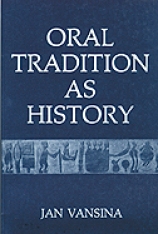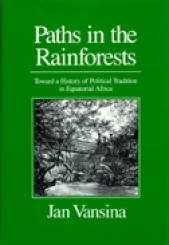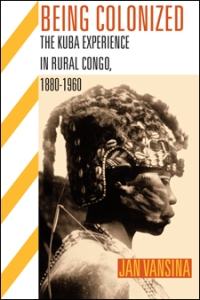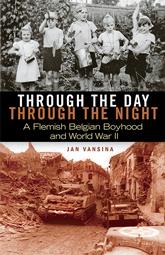For reclaiming the “unknowable” history of Africa in seven landmark books from the University of Wisconsin Press

Jan Vansina. Photo by Catherine A. Reiland / African Studies Program, UW-Madison. Used by permission. All rights reserved.
Jan Vansina, one of the world’s foremost historians of Africa who literally wrote the book on using Oral Tradition as History, was honored at the January 2015 convention of the American Historical Association with its Award for Scholarly Distinction. The honor is awarded for outstanding lifetime achievements in the field of history. Vansina was cited in particular for his many innovations in scholarly methodology, institution-building, and mentoring.
Vansina is considered one of the founders of the field of African history in the 1950s and 1960s, a time not so long ago when there was still a widely held view that cultures without written texts had no history, or that their history was unknowable. Up to that point, “African” historiography focused entirely on the history of European colonizers in Africa, not on the history of Africans.
Vansina was an early recipient of the “Distinguished Africanist” award by the African Studies Association of the United States, and in 2000 he was elected a member of the American Philosophical Society.
In an interview with the University of Wisconsin Press, where he has now published eight books over the course of fifty years (seven on Africa and one on his Belgian childhood), Vansina looked back at how his books published by UWP have influenced the study of Africa’s history, both within Africa and around the world.
“My own case shows that the kind of specialized scholarly books published by university presses typically lead to further research by others and do so for a whole generation or longer. In a field that is new, such as African history was when I began, university presses publish specialized works of scholarship that commercial publishers take no interest in. And I have found that just placing research findings in archives is not enough: publication is absolutely essential to the advancement of research. Indeed, I would argue that university presses are as essential for research in the humanities and social sciences around the globe as are laboratories for research scientists.”
As a young employee of a Belgian research agency sent to the Congo in 1952, Vansina discovered that he could analyze the oral tradition stories he heard from Kuba informants by using the same methods he had learned for extracting historical information from European medieval dirges. This was a historiographical breakthrough that gave the study of pre-colonial African history both the scholarly justification and the self-confidence it had been lacking.
Vansina recalls the impact of his first book with UW Press in 1966, Kingdoms of the Savanna: 
“It was a preliminary historical overview of an area and period in Africa that was little known in academic circles at that point. It was quickly translated into French and published in Kinshasa, and it won the Herskovits Prize for best book from the African Studies Association.”
Although historians were accustomed to studying kingdoms, the book used a very innovative mix of oral and written sources to provide a history of pre-colonial kingdoms in central Africa. At the time, a review of the book in the American Historical Review recognized Vansina’s innovation:
“This signal contribution to African history, and the writing of history more generally, has emerged from the scholarship of one who is ranked by many as among the foremost of the contemporary historians of sub-Saharan Africa.”—American Historical Review
“Over the next twenty-five years or so,” Vansina remembers, “several scholars were inspired by the book to pursue their own research in the past of the various kingdoms I wrote about, so that by the year 2000, individual monographs had been written about nearly all the major kingdoms of the southern savannas (at least five in RD Congo, three in Zambia, and three in Angola).
The impact of Kingdoms outside academia was rather colorful, Vansina recalls. “In Central Africa many in the Congo read it, and it became coveted underground reading for those in the Angolan insurrection against their Portuguese overlords. Its popular impact was especially strong in the lower Democratic Republic of Congo (or RD Congo), where local demand has been strong enough to produce a translation in Kikongo around 1990 and another one in Lingala. In the 1970s there was even a local church calling itself ‘The Church of the Kingdoms of the Savanna.’ ”
In 1978, Vansina published a scholarly monograph, The Children of Woot, on the history of a single kingdom in RD Congo. He comments, “The one completely new feature for a history book was the inclusion of its long lexical appendix, as essential to the argument. A monograph like this is not expected to have a host of readers when it is published but it is expected to attract small numbers of researchers for many years thereafter. Thus even today this book and especially its data have not been superseded by anything else.”
 Oral Tradition as History, a methodological work published in 1985, is Vansina’s book that is most widely known and used in fields beyond African history. “It is a manual about how to handle a certain kind of oral history worldwide, not just in Africa. Some twenty-five years earlier as a young man, what I had written about oral tradition had made a splash and led to extensive debates. This new book was a complete reworking that took into account valid observations made by critics, but still showed the extent to which oral histories of this sort could be relied upon. It has had an active life. For example, it was recently translated into Indonesian Malay.”
Oral Tradition as History, a methodological work published in 1985, is Vansina’s book that is most widely known and used in fields beyond African history. “It is a manual about how to handle a certain kind of oral history worldwide, not just in Africa. Some twenty-five years earlier as a young man, what I had written about oral tradition had made a splash and led to extensive debates. This new book was a complete reworking that took into account valid observations made by critics, but still showed the extent to which oral histories of this sort could be relied upon. It has had an active life. For example, it was recently translated into Indonesian Malay.”
Vansina continued to innovate with his book Paths in the Rainforests (1990), a historical overview built primarily on linguistic and archaeological data reaching more than two thousand years into the past. It attempted a history of the peoples in the Central African rainforests, a large area that had been written off as “without history.”
“But I wrote it as history, introducing new concepts, and included a very large appendix showing the results of comparative linguistic data. No one had ever attempted anything similar, certainly not on that scale, and this book was therefore a bit of a gamble, but it convinced most social anthropologists and archaeologists. I am gratified that from that time onward it has served as an incentive for much further research by others. This year an archaeologist wrote me to say that his discoveries conformed to the predictions the book had made. The most important results of Paths in the Rainforests, though, have been in the field of history, where others have now used similar techniques in their own work, including very deep historical research on the Great Lakes region of East Africa.”
linguistic data. No one had ever attempted anything similar, certainly not on that scale, and this book was therefore a bit of a gamble, but it convinced most social anthropologists and archaeologists. I am gratified that from that time onward it has served as an incentive for much further research by others. This year an archaeologist wrote me to say that his discoveries conformed to the predictions the book had made. The most important results of Paths in the Rainforests, though, have been in the field of history, where others have now used similar techniques in their own work, including very deep historical research on the Great Lakes region of East Africa.”
“Until the publication of Paths in the Rainforests, it was difficult to make more than superficial attacks on the widespread myth that Central African peoples live in ‘impenetrable jungles as their ancestors have lived for thousands of years.’ . . . Jan Vansina’s Paths makes a truly significant contribution to African history by providing a solid framework for the description and integration of a millennium of evolution of the many societies of the vast rainforests.”—Curtis A. Keim, African Studies Review
 As the field of African history matured, Vansina was one of the first to look back at it in a combination historiography and memoir, in his 1994 book Living with Africa. David Henige, longtime African studies librarian at the University of Wisconsin–Madison and co-editor of a UW Press book series in African studies, commented on the significance of the memoir.
As the field of African history matured, Vansina was one of the first to look back at it in a combination historiography and memoir, in his 1994 book Living with Africa. David Henige, longtime African studies librarian at the University of Wisconsin–Madison and co-editor of a UW Press book series in African studies, commented on the significance of the memoir.
“Jan Vansina’s academic career is virtually simultaneous with the field of African history itself. His centrality in the burgeoning field in the 1950s and 1960s was so intense that he was actually called a ‘Culture Hero’ in print, after the anthropological concept that a single figure epitomizes in the collective memory an entire epoch.” —David Henige, University of Wisconsin
Also in 1994, the horrific violence and mass killings in Rwanda returned Vansina’s attention to research he had done in Rwanda from 1957 to 1961. The rich and extensive documentation he had collected was available in an archive there, but no one had made use of it for publications.
 “I knew from that research that Rwanda’s past, and historical memories of that past, were quite relevant to a fuller understanding of the genocide and people’s motivations. I also felt that knowledge of Rwanda’s pre-colonial history could contribute to political choices about its future.
“I knew from that research that Rwanda’s past, and historical memories of that past, were quite relevant to a fuller understanding of the genocide and people’s motivations. I also felt that knowledge of Rwanda’s pre-colonial history could contribute to political choices about its future.
So, I first wrote a book in French about the main social and political developments of the country, directed as much towards Rwanda’s governing elite as towards historians. But the new elite came mostly from Uganda and used English, not French. So I translated the work into English and UW Press published it as Antecedents to Modern Rwanda in 2004.”
“Though its narrative and its major interpretations have been accepted by most academics, and also led to the publication of two academic debates about its significance, in Rwanda there is official silence about the book. It has not been formally banned in Rwanda, but the history I present runs counter to the official ideology and now also to the official history the government promulgates. But I know that actually the book has been widely read in Rwanda, even discussed, but no one will publicly admit to this. I hope that it will eventually be recognized and lead to further research in Rwanda.”
Most recently, in 2010, Vansina experimented with another new approach to African history. “Being Colonized: The Kuba Experience in Rural Congo, 1880–1960 , was my deliberate attempt to write a book for undergraduates. It presents the history of a colony through the eyes of a colonized people. I used sidebars and illustrations, a format still rather uncommon in works of African history. I resisted reducing the historical complexity of the period to simple formulas. The anecdotal evidence so far has it that while most students like it, many find all those names and the very complexity of the history a bit overwhelming as well. But I hope it will inspire others to experiment further with approaches for undergraduates that will open new perspectives to them.”
, was my deliberate attempt to write a book for undergraduates. It presents the history of a colony through the eyes of a colonized people. I used sidebars and illustrations, a format still rather uncommon in works of African history. I resisted reducing the historical complexity of the period to simple formulas. The anecdotal evidence so far has it that while most students like it, many find all those names and the very complexity of the history a bit overwhelming as well. But I hope it will inspire others to experiment further with approaches for undergraduates that will open new perspectives to them.”
Jan Vansina’s legacy also includes an extraordinary impact beyond academia. When the journalist Alex Haley was researching the family history that would become his famous book Roots, a powerful and groundbreaking story of enslaved African Americans, he could find no written documents that directed him to a point of origin in Africa. Eventually, someone suggested that he contact Jan Vansina, who had been doing innovative research on African oral traditions.
Vansina suggested to Haley that the few words, names, and stories that had been passed down to Haley from an enslaved African ancestor named Kunta Kinte might be from the Mandingo people in Gambia, a culture with a very rich oral tradition recited by trained griots. Eventually Haley’s quest led him to a griot in a remote Gambian village who had memorized the history of a large, extended Kinte family. Two hours into the recitation, the griot mentioned a young man, Kunta, who went away from his village to chop wood and was never seen again. This astonishing connection was the beginning of a great movement of reclamation of African heritage by African Americans.
 Now 85 years old and professor emeritus at the University of Wisconsin–Madison, Vansina recently published his eighth book with the University of Wisconsin Press, departing from African history to write a memoir of his youth in war-torn Belgium: Through the Day, Through the Night: A Flemish Belgian Boyhood and World War II.
Now 85 years old and professor emeritus at the University of Wisconsin–Madison, Vansina recently published his eighth book with the University of Wisconsin Press, departing from African history to write a memoir of his youth in war-torn Belgium: Through the Day, Through the Night: A Flemish Belgian Boyhood and World War II.
“Not only a personal narration about the Flemish struggle to achieve cultural and political recognition, Vansina’s Through the Day, Through the Night is also a lesson on how history and memory work.”
But Vansina is not done yet; the rich research notes and knowledge of primary sources that he’s accumulated over a lifetime of scholarship will doubtless result in continuing innovative and influential work on the history of Africa.

One comment